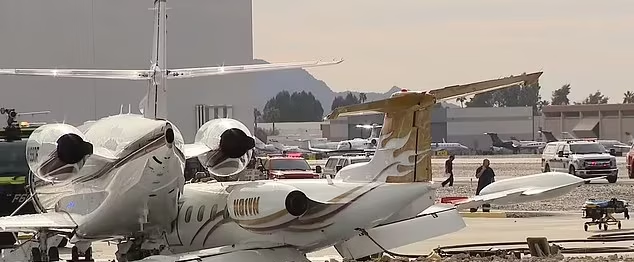A disastrous air accident occurred on February 10, at the Scottsdale Airport in Arizona, with a private jet veering off the runway and leaving one dead and others injured. Facts surrounding the accident are brutal as well as helpful in better understanding the issue with air safety protocols and induction into investigations underway. Let’s see what happened, its consequences, and its implications for safe air travel.
What Happened in the Scottsdale Plane Crash?
It was a routine, regular day as the aircraft landed at Scottsdale Airport owned by rock musician Vince Neil. However, things got pretty ugly as this aircraft veered off the runway after touching down and subsequently hit another parked Gulfstream jet. This accident incident managed to claim one life and left four others hurt in the process. The injuries varied; while some were in the form of cuts and scrapes, others’ were worse, such as fractured ribs.
It was described as very chaotic. The observer recalled saying, “I saw the gear shear off… and they were doing probably about 100 knots when I saw them exit the runway.” In this statement, the aircraft loses its left landing gear, resulting in an uncontrollable trajectory for the aircraft. Without thrust reversers, this makes it difficult for the pilots to regain control.
Also read: Gulf of Mexico Renamed to Gulf of America by Donald Trump
Casualties and Injuries: Who Was Affected?
Among those aboard were Vince Neil’s girlfriend and her friend. Fortunately, Neil himself was not on the flight. However, both women were taken to the hospital due to injuries sustained from the crash. The severity of the accident shocked the general public and the aviation community at large since there had been a recent series of air mishaps.
The Federal Aviation Administration (FAA) responded very rapidly by grounding all flights into Scottsdale Airport as investigations began. This effectively shut down operations and the seriousness with which such incidents are treated and gone to extreme pains to find out what the cause was for the crash.
FAA & NTSB Investigation: What Caused the Crash?
Landing Gear Failure: A Critical Factor?
The FAA and NTB will begin conducting investigations immediately after the crash. The primary aim is to determine the cause of the failure in landing gear. These investigations are important not only for understanding this incident but also for preventing such incidents in the future.
Recent Air Accidents: A Growing Concern
However, the onus of finding the answers is somewhat heavy because this latest spate of disasters has come within the past fortnight and has accounted for an unenviable tally of a collective loss of 84 lives. This run of unsettling incidents has caused considerable concern for the safety of aviation and the need to question operational norms in minute detail.
Also read: BigBear.ai (BBAI) Stock Analysis: Future, Risks & Growth
Eyewitness Accounts: What Did People See?
The eyewitness account from the witnesses to the crash was chillingly terrifying as to what happened. An eyewitness says he watched from a perspective and that the left main gear sheared off immediately, thus leading to an immediate loss of control. “Something bad’s going to happen,” they thought to themselves as they saw the plane exit the runway. Many people feel the uncertainty of air crash incidents, and this reflects their concerns.
This usually remains the gold in investigations since it gives a basis for understanding what may not have been deduced from technical data alone. One is sure to carry with him or herself this emotional impact of having witnessed such a tragedy for a long time, and therefore, their accounts are usually very instrumental in trying to understand the sequence of events that led to the crash.
Aviation Safety Concerns: Can Future Crashes Be Prevented?
The Importance of Aircraft Maintenance
The investigation centers on the technical failure of the left landing gear of the aircraft. The initial reports show that the gear failed when the aircraft landed, but there is a need for further examination to establish the underlying factors that led to the failure. Was it a mechanical problem a pilot error, or both?
The aircraft manufacturer and the user must keep up with their demanding maintenance schedules and obey safety precautions to prevent such tragedies. Although fatal, this accident carries the maximum implication in terms of injuries after the incident and dictates questions on the reliability of aircraft systems as well as the effectiveness of the present measures of safety available.
Reflective Thoughts on Aviation Safety
The sad event reminded one of the fact that with better technology and increased safety, aviation still bears a significant amount of risks themselves. While the aviation sector has seen massive strides in improvement towards safety, the fact is nothing can ever be improved or made safer forever.
This gap will be bridged together with transparency through collaborative efforts among manufacturers, operators, and regulating authorities but would be the eventual medicine to make safety a very key priority as this point forward, and inquiries continue with further revelations arriving each day.
Final Thoughts: Remembering the Victims & Moving Forward
It was a tragic plane crash in Scottsdale that affected many lives. As we await further details on the FAA and NTSB investigations, we must not forget the human face of such events. Behind each statistic is a story, and every life lost is a tragedy that reverberates through families and communities.
The aviation industry has always demonstrated its ability to stand by safety, working hard to avoid accidents. Lessons learned here will surely mark policies and practices set forth to protect the passenger as well as the crew. Our thoughts are with the victims and their families; we hope the injured can recuperate quickly.








